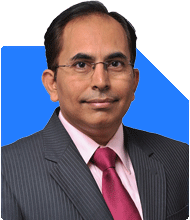Ramalingam Kalirajan |10879 Answers |Ask -Follow
Mutual Funds, Financial Planning Expert - Answered on May 16, 2024
He has an MBA in finance from the University of Madras and is a certified financial planner.
He is the director and chief financial planner at Holistic Investment, a Chennai-based firm that offers financial planning and wealth management advice.... more

My age for 25 year i need 80000 thousands par months after retirement. Hou much i have to invest in nps to get the same
Understanding NPS
National Pension System (NPS): NPS is a voluntary, long-term retirement savings scheme offered by the Government of India.
Investment Options: NPS offers various investment options, including equity, corporate bonds, and government securities, allowing you to choose a suitable asset allocation based on your risk tolerance and investment goals.
Retirement Income: The accumulated corpus in your NPS account can be used to purchase an annuity, providing you with a regular income stream during retirement.
Estimating Retirement Corpus
To generate a monthly income of 80,000 after retirement, we'll first calculate the required retirement corpus based on your life expectancy and expected rate of return.
Calculation Steps
Monthly Income Requirement: 80,000 (as per your requirement)
Annual Income Requirement: 80,000 * 12 = 9,60,000
Annual Income in Retirement: Assuming a conservative 6% annual return post-retirement, the corpus required would be:
Retirement Corpus = Annual Income Requirement / Expected Annual Return
Retirement Corpus = 9,60,000 / 0.06 = 1,60,00,000
Determining NPS Contribution
Given your age of 25, you have a considerable investment horizon, allowing you to benefit from compounding returns over time. Let's calculate how much you need to invest in NPS to accumulate the required retirement corpus.
NPS Calculator
Using an NPS calculator with assumed rates of return and retirement age, you can determine the monthly contribution required to achieve your retirement goal.
Conclusion
To ensure a comfortable retirement with a monthly income of 80,000, you need to start investing in NPS early and contribute regularly. Consider consulting with a Certified Financial Planner to develop a personalized retirement plan aligned with your financial goals and risk tolerance.
Best Regards,
K. Ramalingam, MBA, CFP,
Chief Financial Planner,
www.holisticinvestment.in
You may like to see similar questions and answers below
Ramalingam Kalirajan |10879 Answers |Ask -Follow
Mutual Funds, Financial Planning Expert - Answered on Apr 23, 2024
Ramalingam Kalirajan |10879 Answers |Ask -Follow
Mutual Funds, Financial Planning Expert - Answered on Apr 25, 2024
Ramalingam Kalirajan |10879 Answers |Ask -Follow
Mutual Funds, Financial Planning Expert - Answered on May 11, 2024
Ramalingam Kalirajan |10879 Answers |Ask -Follow
Mutual Funds, Financial Planning Expert - Answered on May 19, 2024
Janak Patel |71 Answers |Ask -Follow
MF, PF Expert - Answered on Feb 04, 2025
Mayank Chandel |2572 Answers |Ask -Follow
IIT-JEE, NEET-UG, SAT, CLAT, CA, CS Exam Expert - Answered on Dec 11, 2025
Mayank Chandel |2572 Answers |Ask -Follow
IIT-JEE, NEET-UG, SAT, CLAT, CA, CS Exam Expert - Answered on Dec 11, 2025
Ramalingam Kalirajan |10879 Answers |Ask -Follow
Mutual Funds, Financial Planning Expert - Answered on Dec 11, 2025
Samraat Jadhav |2507 Answers |Ask -Follow
Stock Market Expert - Answered on Dec 11, 2025
Samraat Jadhav |2507 Answers |Ask -Follow
Stock Market Expert - Answered on Dec 11, 2025
Samraat Jadhav |2507 Answers |Ask -Follow
Stock Market Expert - Answered on Dec 11, 2025
Samraat Jadhav |2507 Answers |Ask -Follow
Stock Market Expert - Answered on Dec 11, 2025
Dr Nagarajan J S K |2577 Answers |Ask -Follow
NEET, Medical, Pharmacy Careers - Answered on Dec 10, 2025
Mayank Chandel |2572 Answers |Ask -Follow
IIT-JEE, NEET-UG, SAT, CLAT, CA, CS Exam Expert - Answered on Dec 10, 2025
Samraat Jadhav |2507 Answers |Ask -Follow
Stock Market Expert - Answered on Dec 10, 2025























